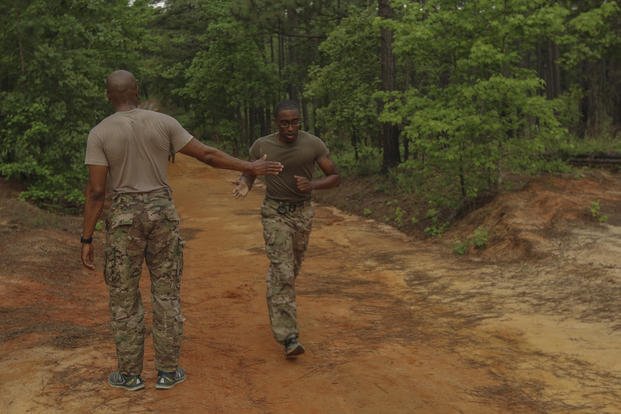Historically, the Army Rangers have utilized a longer-than-average timed run for their assessment test into Army Ranger School and the Ranger Battalions/Regiments screening program, the Ranger Assessment and Selection Program (RASP). This five-mile timed run is the longest assessment tool in the U.S. military to enter these special training programs. They require excelling in running and rucking, as the miles each week in training accumulated are high.
You will see running, rucking and high-repetition calisthenics while preparing for Ranger School through the Ranger Fitness Test. Candidates must pass these minimum physical requirements, which include the Ranger Fitness Test (41 T push-ups in two minutes, 2:35 plank, five-mile run in 40 minutes or less, and six pull-ups), water survival assessment and a 12-mile ruck with a 35-pound rucksack and weapon in under three hours (Army Ranger Regiment Recruiting page).
Here is a question from a soldier preparing for this course and wants to improve his time on the five-mile run:
Stew, for the 5-mile run under 40 minutes, I can run it in 39 minutes. Should my next focus be goal pace repeats for 800-meter increments if I'm trying to get it down to a 35-minute 5-mile? Thanks, Nick
Just so you know, there are discussions about changes to the Ranger Fitness Test, with the new Ranger Fitness Assessment (RPA) 2.0 to reflect many tactical fitness changes within the military services, especially within the special operations communities. The assessment testing started in late 2023 and will likely continue throughout 2024. Whether this new assessment will be implemented is to be determined.
The new RPA 2.0 looks like this:
- One-mile run
- Six chin-ups
- 100-meter kettlebell carry (fast)
- 100-meter individual movement techniques, or IMT: Three- to five-second sprint, drop to prone position for 100 meters
- 100-meter SKEDCO drag (185 pounds)
- Two-mile run
Measured by total time: _________ *under 27 minutes
But for now, my recommendation is to train to do both. Though it is a different testing model, the running and the pull-ups are similar, and the training after the test will still require many miles of running and rucking. Being able to do five-mile timed runs is still wise to have as a base of your training. The added load-bearing skills will require some specific additional training in the calisthenics and cardio portions of the current test. The water assessment and the ruck are still part of the new assessment.
I advise doing two things: Work on your goal pace of seven-minute miles and do some Zone 2 cardio base training with easy running and rucking. One will help your speed and pace, and the other will help get you over the hump of longer-distance running and rucking ability. Try this:
Monday, Wednesday, Friday: Add in goal-pace running at a six- to seven-minute mile pace for such distances as 400 meters, 800 meters and a mile. Working on these repeat sets for 8-12 400-meter runs, 5-6 800-meter runs, and 4-5 one-mile runs at goal pace through the week will help your muscles remember the pace you need to hit your mark of a 35-minute, five-mile run.
Tuesday, Thursday, weekend day: Make these run and/or rucking workouts (or nonimpact cardio workouts focus on a heart-rate zone (Zone 2). This is a moderately leisurely pace, also known as "conversational pace," but the research shows it is a valuable training tool to build your aerobic ability. Some call this level of work building the aerobic engine. However, if you are not used to running this much in a week with the above pacing work, limit these miles or pacing miles. Replace them with a nonimpact version, with one mile of running or rucking missed equaling 10 minutes of nonimpact cardio, such as biking, rowing, the elliptical machine, stair stepper and swimming.
If replacing any running on a pacing day, increase the intensity of those nonimpact cardio events by doing intervals, such as Tabata (20-second sprint/10 seconds easy) or fast/slow (one minute fast/one minute slow). If replacing Zone 2 running or rucking, do a moderate intensity bike or other nonimpact cardio at about 50% of your maximum heart rate.
Stew Smith is a former Navy SEAL and fitness author certified as a Strength and Conditioning Specialist (CSCS) with the National Strength and Conditioning Association. Visit his Fitness eBook store if you're looking to start a workout program to create a healthy lifestyle. Send your fitness questions to stew@stewsmith.com.
Want to Learn More About Military Life?
Whether you're thinking of joining the military, looking for fitness and basic training tips, or keeping up with military life and benefits, Military.com has you covered. Subscribe to Military.com to have military news, updates and resources delivered directly to your inbox.


















